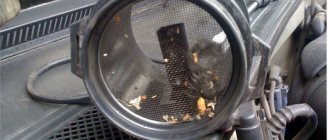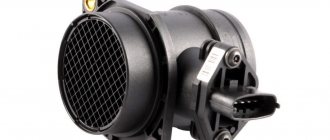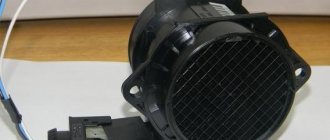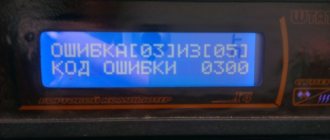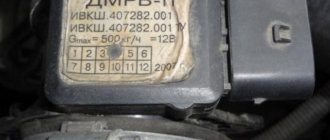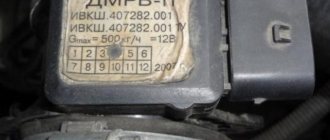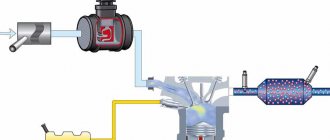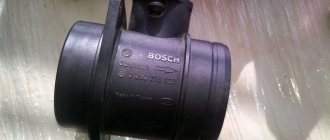The data that the sensor sends to the system determines whether the correct amount of fuel or a lean mixture will be supplied to the engine cylinders. Which, ultimately, will lead to a loss of traction of the power unit, and then to the fact that the engine will completely stall. Let's consider the device in the context of the VAZ 2114 model, which is considered one of the most popular in our country at the moment. What is the VAZ 2114 mass air flow sensor, how to check the sensor and how is repair carried out?
Purpose of the mass air flow sensor
The mass air flow sensor is a complex electronic device that regulates the fuel injection system into the engine cylinders. It is responsible for how much air is contained in the engine. It is known that in order for the power unit to come into action, it is necessary that air and fuel be supplied in half. Then an atmosphere is created inside the equipment that is ideal for striking a spark and setting all mechanisms in motion.
The difference is significant. The system, receiving this information, trustingly follows it. The proportions of air and fuel are disrupted, and a slightly smaller amount of fuel is injected, which is called a “lean mixture.” Symptoms of this problem are a sharp decrease in engine power, controllability and dynamics. The consequence of this “disease” is the engine’s refusal to start. And then the driver has to puzzle over what actually happened.
Therefore, from time to time you should check the working condition of the sensor, so as not to waste much more time on engine diagnostics. There are several ways to check the sensor, but the most popular is diagnostics using a multimeter - a simple device that every car owner would do well to keep in his toolbox.
Symptoms and troubleshooting
Since the mass air flow sensor is electronic equipment, and a very complicated one at that, most car owners do not dare diagnose it themselves and take it to a car service center the old fashioned way. But quite often, having just connected the diagnostic device to the sensor, the auto repairman declares that the device is completely faulty, it cannot be repaired, and its place is only in a landfill. Rest assured, if you bring in a completely new sensor, the technician will tell you the same thing.
But any disinterested expert will say that the mass air flow sensor is an almost indestructible device. It may malfunction, sometimes seriously, but this is a completely fixable problem, something that will take no more than an hour. But how to check the mass air flow sensor for performance? Very simple. If, after installing a new sensor on your car, you notice that it works perfectly, then that is where the problem lies. If the situation has not improved at all, then there is no point in wasting your energy, time and money on the empty hassle of replacing a completely “healthy” sensor.
Just above we mentioned such a device as a multimeter. You can understand whether the sensor is working or not by finding out the voltage of the device. If everything is normal, then the multimeter produces 1-1.2 W. If there are any problems, then the scale goes down, the critical mark starts at 0.99 W. If, on the contrary, the voltage is higher than normal, for example 1.037, then this indicates one thing: the sensor is very clogged, and therefore makes errors in the readings. If you clean it, it will work again at the same rate.
First of all, this is a sharp increase in fuel consumption. Here you should not blame the car for its large “appetites”: it is not to blame, and the manufacturer is not to blame, here you just need to “treat” your “iron horse”. Of course, this can happen not only in the case of a sensor failure, but from this fact alone you can come to the right idea: most likely the problem lies in the tiny device.
Also, when the engine loses power, a hot engine will stop starting. The car, previously dynamic and controllable, turns into some kind of monster on wheels, which is constantly lost in control and “freezes”. And finally, if you see a simple Check Engine sign on the instrument panel, then there can be no doubt: this sensor is asking you for an ambulance.
Sensor repair
Any electronic device has a huge disadvantage: sensitivity to the slightest power surges, pollution, aggressive environmental influences and many other factors. If even a tiny particle of dirt or dust gets into the air flow entering the engine, it will certainly settle on the sensor, which, being so vulnerable, attracts such troubles to itself like a magnet.
Continuing to work in this state, he is forced to increase the load, as dust ballast interferes with him. Consequently, it starts to fail. Also, if low-quality oil or bad gasoline is poured into the engine, all this first of all has a very negative impact on the electronic device. That is why it is so important to pay attention to air, oil and other filters and not to skimp on the quality of fuels and lubricants poured into the engine.
Having made sure that the VAZ mass air flow sensor is faulty, we move on to the next stage - repair. Repair consists of a good cleaning. But how is the mass air flow sensor cleaned and is it possible to do this work with your own hands? To begin with, you should remember, like a multiplication table, that in no case should you use the following for flushing:
For cleaning, use carburetor cleaning fluid. The most popular in this matter is WD 40, which has good technical properties and is safe for electronic devices. You need to wash the sensor carefully so as not to damage the thinnest plates and wiring.
After making sure that there is no more dust or debris in the device, you can, after thoroughly drying it, install it in place. As a rule, after such a simple procedure, the device should work like a good Swiss watch. We have discussed the most frequently asked questions regarding the mass air flow sensor. Now you know why it breaks, what needs to be done to protect it, and what to do if it suddenly malfunctions. We wish you good luck on the roads and good mood!
How to check the mass air flow sensor on a VAZ 2114 car with your own hands?
The mass air flow sensor is used to estimate and balance the air flow entering the engine. Signals from the device are sent to the motor control unit. Based on data from the mass air flow sensor and other sensors, the required mixture composition is formed. To prevent the device from breaking down on the road, it is necessary to diagnose it. There are several ways to check the mass air flow sensor on a VAZ 2114.
This is interesting: Adjusting the Gazelle rear axle gearbox
Full list of VAZ 2114 sensors: name and location
Most of the units we are considering are located in the engine compartment. We present to your attention a diagram of the arrangement of sensors on the VAZ 2114 engine:
The location of the sensors must be known to the responsible motorist
List of VAZ 2114 sensors:
- Camshaft position (phase sensor);
- Coolant temperature;
- Detonation;
- Oil pressure;
- Oxygen sensor (lambda probe);
- Kneeshaft position;
- Speed;
- Idle move;
- Mass air flow;
- Fuel level;
- Gasoline level;
- Antifreeze level;
- Throttle Positions
Now let's look at the sensors and their location in more detail.
Crankshaft position sensor
DCP is a device that supplies the computer with information about the position of the crankshaft. The correct functioning of the fuel mixture supply and ignition systems, as well as the injectors of the injection engine, depends on the operation of this unit.
This device is often called a synchronization sensor, since the ECU, based on information received from the DCPV, determines the moment of fuel injection into the engine cylinders. If the DCPV breaks down, incorrect information will be supplied to the brains of the fourteenth and the engine will lose its performance, since there will be malfunctions in the fuel supply system and the injectors will not be able to function normally.
On the fourteenth, inductive type DCPVs are installed, the approximate cost of a new device is 150 - 200 rubles. The DCPV is located near the alternator belt, near the camshaft.
Camshaft position sensor
DPR is often called a phase sensor. This device is available on all fourteen cars with 16-valve engines, and on VAZ-2114 with 8-valve engines with phased injection of the fuel mixture.
The DPR transmits data about the current operating cycle of the power unit to the ECU:
- Which valve is open?
- What valve timing is being implemented at the moment.
Based on the information received, the ECU determines the timing of fuel injection so that gasoline is supplied just before the intake valve opens.
The device is located on the engine, near the cylinder head, not far from the air filter.
Throttle position sensor
TPS is one of the key devices, the correct functioning of which depends on the operation of the fuel system. As the name implies, TPS transmits information to the brains of the fourteenth about at what angle the throttle valve is placed at a particular moment in time
One of the main characteristics of the TPS is the frequency of the signal, based on the change in which the engine control unit determines the degree to which the gas pedal is pressed, which allows the brain to select the optimal engine cooling mode and the amount of fuel supplied.
TPS is part of the throttle assembly. It is located on the throttle body, next to the idle speed sensor.
Knock sensor
A properly functioning DD is the key to the normal functioning of the fourteenth engine. If it breaks down, the engine will run rough and gas mileage will increase.
The DD reacts to engine vibrations, information about which is transmitted to the ECU, which allows the ECU to select the correct ignition timing (the moment of ignition of gasoline in the cylinder).
The device is mounted on the engine cylinder block next to the fan, between the 2nd and 3rd cylinders.
Coolant temperature sensor
DTOZH (also referred to as the VAZ 2114 engine temperature sensor) is located at the place where the inlet pipe is located on the body of the cylinder cooling system, to which the antifreeze supply pipe is connected.
DTOZH is distinguished by its durability and simplicity of design; its only task is to monitor changes in the temperature of the fluid in the engine cooling system. The ECU uses data received from the DTOZH to adjust the crankshaft speed, the ratio of the mixture of gasoline and air, and to select the ignition timing.
DMVR device on VAZ 2114
The overall design of the sensor consists of two filaments made of a platinum-based alloy. The threads are heated by electric current, with one being the working thread and the other being the control thread. The working element is located in the air flow supplied to the engine, which cools the part. As the temperature of the filament changes, resistance increases or decreases. The data is compared with the parameters of the control element, and based on this, the amount of air passed is automatically calculated.
On later VAZ 2114 models, thermistors began to be used, which have increased durability and measurement accuracy. This is exactly the sensor that is used on the VAZ 2114.
Where is the mass air flow sensor located?
The mass air flow sensor on the VAZ 2114 is located in the air duct located behind the air purification filter. A wiring harness is connected to the sensor, ending with a plug.
Installation location of the air flow sensor on the VAZ 2114 engine
Sensor design features
The VAZ 2114 can use mass air flow sensors of domestic and imported origin. The design of the devices is the same and corresponds to the diagram below.
Design of the air flow sensor VAZ 2114
The DMRV includes:
- 1 — block for connecting the wiring harness;
- 2 — sensor operation controller;
- 3 - measuring element;
- 4 — outer body;
- 5 — metal protective mesh;
- 6 — guide deflector;
- 7 — fastening the sensor body to the body;
- 8 — direction of air flow.
When should you clean the sensor?
The condition and degree of wear of the air filter on which the first one is installed is of great importance for the long and proper operation of the sensor. So, if the filter is in good working order and does a good job of filtering dust particles and small abrasive particles in the air, then the sensor will last a long time. If the filter wears out, the sensor quickly becomes dirty and stops working correctly.
You can find out that the VAZ 2114 DMRV needs to be cleaned by one of the following signs:
- the car is poorly controlled when accelerating, there are sharp drops in speed, acceleration and jerking;
- engine speed at idle is extremely high or, on the contrary, intermittent;
- fuel consumption has increased sharply (in the case of the 14th model it can increase even by 50%);
- the engine stopped starting.
Clogged air flow regulator
Cleaning the air flow sensor using mechanical force or a jet of compressed air is strictly prohibited - such a procedure will instantly lead to its breakdown.
In most of these cases, it is not necessary to immediately run for a new sensor - simply cleaning it will help.
What is the optimal air flow for VAZ 2114 cars?
The amount of air required to form the mixture depends on the speed:
- at idle speed (850-950 rpm) - 9.5-10.5 kg of air per hour;
- at medium speed (2000 rpm) - 19-21 kg of air per hour.
Reducing the air supply leads to a leaner mixture, and increasing it leads to a richer mixture. Small deviations in measurement accuracy have little effect on the operation of the engine, but with errors of 2-3 kg, the engine begins to operate unstably. Some control units compensate for measurement inaccuracies based on data from other sensors. For example, the January 5.1 block additionally adjusts the mixture composition based on the signal from the lambda probe.
The role of the mass air flow sensor
The task is to create a mixture of gasoline vapor and air. The sensor is capable of measuring two indicators that are strongly related to each other:
- Reaction time;
- Amount of air used.
Receiving accurate data, the meter determines the optimal amount of components to create the proportions of air with fuel vapor. If the mass air flow sensor begins to produce incorrect values, the mixture will not correspond to the operating mode of the engine in which it is currently operating.
As a result, power drops, fuel consumption increases, response decreases, and acceleration takes much longer. Depending on the sensor, its delay may manifest itself in the form of dips during acceleration or floating speed at idle.
Optimal air flow
Since we are talking about the VAZ 2114, we should determine what air flow rate is optimal for its engine.
A working sensor under operating conditions of a 1.5 liter engine at approximately 900 rpm, the amount of air consumed will be from 10 kg with an error of 0.5 kg per hour. If you raise the speed to 2000, then the consumption will increase to approximately 19-21 kg.
When the amount of air decreases at the same speed, the dynamics will immediately begin to decrease, but at the same time fuel consumption will decrease. If the air flow increases, the dynamics will increase, and fuel consumption will also increase.
The sensor should not be allowed to deviate by more than 2-4 kilograms, since under such circumstances the operation of the engine will be very capricious and unpredictable.
Causes of failure
In fact, air flow sensors can only fail for reasons that are hidden in the crankcase ventilation.
This ventilation system is dual-circuit; it is responsible for operating in two modes - with the throttle valve closed or open. If the damper is closed, gases from the crankcase exit through the line. But a certain proportion of gases accumulates inside the idle line. In this case, the gas comes into contact with the resistor of our sensor, although it is covered with a film. Due to the resin that settles on the resistor, the mass air flow sensor begins to produce incorrect information. From here a chain of malfunctions arises.
Signs of breakdown
If the sensor fails, a variety of symptoms may appear, but ultimately this will lead to a malfunction of the motor. At first, the engine’s appetite for gasoline may increase, then floating speeds will be observed, etc.
There are several characteristic signs that indicate a breakdown of the mass air flow sensor:
- Dips are observed when the engine is running under load and at idle;
- The car begins to accelerate more slowly, the dynamics noticeably suffer;
- When changing gears, the engine turns off;
- Power drops;
- Fuel consumption increases;
- When the engine is hot, the engine is difficult to start;
- The Check Engine light comes on on the dashboard.
If the sensor does not show even the slightest signs of life, the lamp on the panel may not light up. In this case, the breakdown is determined by the operation of the on-board computer and errors.
You can perform diagnostics by determining the sensor signal level. If the level is low, this indicates:
- No sensor connection;
- Breaks in the circuit;
- Oxidation and breakage of mass in the chain;
- Malfunction of the electronic engine control unit;
- Short circuit or breakage of signal wires;
- A failed mass air flow sensor.
Even if you discover a breakdown, do not rush to purchase a new mass air flow sensor, since this sensor costs from 1.5 to 4 thousand rubles.
In some situations, simply checking and cleaning the air flow sensor can help. Moreover, it is not at all necessary to contact the service center. You can easily complete the task with your own hands.
The main causes of failure of the mass air flow sensor
The most common causes of sensor failure are:
- dust ingress;
- oil contamination;
- short circuit of the wiring due to damage to the insulation or plug;
- mechanical damage to active elements.
What factors disable the mass air flow sensor?
Factors causing failure of the air flow sensor:
- Dust may be caused by improper installation of the sensor on the filter, which causes the sealing ring to become distorted. With this defect, a thin coating of contamination will be present on the sensor input grid. Another cause of dust is a clogged air filter, so regular maintenance will prolong the life of the air flow sensor.
- Oil is thrown onto the sensor if the level in the crankcase is high or if the oil separator in the ventilation system is clogged. An additional negative factor is engine wear, which causes lubricant to actively enter the crankcase ventilation.
- Contact with sharp objects on the insulation, oiling. Such impacts are the result of careless repairs.
- Damage to the sensor is possible during vehicle maintenance (impacts to the body) or during improper cleaning of the active part.
Prevention of breakdowns and cleaning of the air flow sensor of the VAZ 2114
The flow meter sensor is located in a vulnerable place: exposure to temperature changes, moisture, dust.
Precision electronics located in the measuring channel fail when foreign objects enter.
- untimely replacement of the air filter;
- the use of so-called “zero” filters;
- loose connection of the mass air flow sensor with the air duct flanges;
- moisture entering the air intake;
- Debris left in the ductwork or filter housing after repairs and maintenance.
How to clean the mass air flow sensor if contamination does not render it inoperable
The sensor must be removed, the protective nets removed, and blown with clean compressed air. If there is dried dirt or oil stains, washing with special means for mass air flow sensor is required. Of course, it is necessary to clean the air duct itself with the filter housing.
In most cases, such prevention brings the flow meter back to life.
How to check the mass air flow sensor yourself?
To independently check the sensor, there are several methods based on disconnection, as well as inspection and testing with a multimeter. There are no other diagnostic methods at home. A thorough inspection of the mass air flow sensor is carried out on a special stand, which makes it possible to record sensor problems under various operating modes. Another common testing method is to install an identical device removed from another vehicle.
Disabling the mass air flow sensor
Visual inspection
External inspection requires removal of the air duct from the sensor. During the inspection, the dustiness of the inside of the housing and the corrugated air supply hose is assessed. There should be no traces of oil or dust on the surface.
Checking the device with a multimeter
The purpose of diagnostics is to measure the voltage supplied by the sensor.
Bosch products are checked in a similar way:
To measure you will need:
- test device:
- a set of measuring probes;
- WD-40 liquid.
The measurement is made between the yellow and green wires. Voltage values can be displayed on the screen of some on-board computers (menu voltage from sensors, U Mass air flow sensor).
Checking the mass air flow sensor using a multimeter is demonstrated in the video from “IZO))) LENTA”.
Determining the pinout of the mass air flow sensor
The location of the wires in the block starting from those closest to the windshield:
- yellow - positive input signal (in diagram 7);
- gray-white insulator - positive power signal (in diagram 12);
- green — sensor grounding (in diagram 30);
- pink-black insulator - sending a signal to the main relay.
Pinout of DMRV contacts
Other colors of wiring insulation are possible, but the pinout sequence remains unchanged.
Instructions for testing
- Insert the probes into the connector to the places where the wires are installed. To facilitate the procedure, the probes are lubricated with WD-40 liquid. The positive signal comes from the yellow wire, the negative signal from the green wire. It is not recommended to pierce the insulation and use additional cables, as this reduces the accuracy of the measurement.
- Switch the multimeter to DC voltage measurement mode with a limit value of 2.0 volts.
- Turn on the ignition, do not start the engine.
- Measure the voltage and compare it with the required value.
Comparison of test results with established standards
In accordance with the table, the sensor state is determined based on the measurement results.
Examination
There are several ways to check the functionality of the flow sensor. But first you need to determine where the desired object is located.
And our hero is in the engine compartment. Find the air filter pipe there. It is on this that the mass air flow sensor is located, which monitors the air flow passing through the filter. Replacing it is simple - just dismantle the device by removing it from its fasteners and putting a new one in place.
Now regarding the verification.
- Disconnect the sensor by disconnecting the wiring harness from the connector. Press the latch at the bottom and you'll be good to go. Now start the engine and raise the speed to at least 1500 rpm. By turning off the sensor, the car will perceive this as an emergency condition, so the mixture will be prepared depending on the current throttle position. Drive a short distance. If the car accelerates faster than usual, the mass air flow sensor has definitely failed.
- Replace the firmware. The original firmware of the electronic control unit is often changed. Therefore, we cannot find out which sensor operation algorithm was prescribed in the case of the first verification method. The throttle valve has a stop; a plate approximately 1 millimeter thick should be placed under it. This will increase the speed. Now the chip with the sensor is disabled. If the mass air flow sensor does not work, the engine will stall. If this does not happen, then the firmware is not original, the steps of the idle speed control are written incorrectly.
Checking with a multimeter
To do this, you will have to use a multimeter. And how can I check the functionality of the sensor using this method? Select the DC voltage measurement mode on the device and set the maximum value to 2V.
Check with a multimeter
Separately, you should familiarize yourself with the connection diagram in the case of the VAZ 2114.
| Subsequence | Wire color | Meaning |
| 1 | Yellow | Incoming signal |
| 2 | Gray-white | Power output |
| 3 | Green | Grounding |
| 4 | Pink-black | Main relay output |
In some cases, the color may differ, but the sequence always remains the same. This will prevent you from getting confused.
Turn on the ignition with the engine off. The positive probe of the multimeter is connected to the yellow output of the sensor, and the black, that is, positive, goes to the green.
The probes of the measuring device should be inserted through the rubber seals of the connectors without damaging the insulation. The probes should be moistened with the almighty WD 40. Now measure the voltage readings. Compare the result obtained with the data from the table.
| Voltage indicator | Air flow sensor condition |
| 1.01-1.02V | The air flow sensor is in good working order, almost new condition, can serve for a long time |
| 1.02-1.03V | The sensor is in good condition, although old. There are no complaints about performance |
| 1,03-1,04 | The air flow sensor is in poor condition, has almost expired and will require immediate replacement |
| 1,04-1,05 | The condition is critical, the resource is exhausted. It is recommended to replace it as soon as possible to avoid troubles. |
If you install a new sensor, it will initially show readings in the region of 0.996-1.01 V, but over time the voltage will begin to increase. This indicates wear.
Restoring the air flow sensor
They ask for a considerable price for a mass air flow sensor, and according to the laws of the market, this should be justified. It's simple, though! To a large extent, this is the price to pay for our ignorance - we have no idea how the mass air flow sensor works... and why it stops working. And also - for the opinion imposed on us by market traders: the mass air flow sensor is depressed - buy a new one!
The role of the mass air flow sensor is difficult to overestimate. In order for the controller to accurately control the operation of the injectors and ignition, it must, as far as possible, accurately know the actual air flow of the engine. If the mass air flow sensor starts to lie, the engine loses power, fuel consumption and exhaust toxicity increase, and acceleration dynamics worsen.
One of the common reasons for the malfunction of the mass air flow sensor on the “tens” lies in the features of the engine crankcase ventilation system. It has two circuits - a large one, which operates when the throttle is open, and a small one - for idle mode when the throttle is closed. In the latter case, crankcase gases are sucked into the throttle body through a channel with a hole diameter of 1.5 mm. Some of them pass along the idle line, through its regulator, at the same time coming into contact with the delicate film resistor of the mass flow sensor. In addition, the latter is located in the zone of action of reverse gas oscillations in the intake tract. Resin deposits change the characteristics of the resistor - and the sensor becomes false. By this time, the idle speed controller begins to act up in its own way - it sticks, jams, especially when starting the engine.
This is interesting: Do-it-yourself engine cooling radiator repair
Usually the mass air flow sensor is checked with a diagnostic device (for example, DST-6), but we will make do with a digital multimeter with a scale of up to 2 V. We insert a pin between the rubber seal and the yellow wire until it makes contact (photo 1). Now turn on the ignition and measure the voltage at this contact. Ideally, the result should be 0.99 V. Taking into account measurement errors, no more than 1.03 V. If it is higher, some people immediately replace the sensor with a new one. We won't rush. Having unscrewed the tricky screws securing the sensor's measuring element with pliers, we will instead select simple ones (4.9 x 20) for a Phillips screwdriver. This will make servicing the machine easier in the future. Let's work with the removed element. Let's prepare a washing device - an aerosol carburetor cleaner, the tube of which, heated in the flame of a match, will be bent at an angle of 90°. Then we cut it so that the stream is knocked out to the side, and the tube itself remains straight (photo 2). By introducing it to a depth of 10 mm into the upper channel of the measuring element of the mass flow sensor, we will flush the resistor. A few seconds later - again. As a rule, no more is required. Please note that the resistor does not allow any force - forget about cotton swabs, brushes, compressed air.
After allowing traces of the cleaner to dry, we insert the sensor into the housing and repeat the voltage measurements. Hasn't changed? Apparently, the MAF resource has really been exhausted. Usually, the “top ten” needs to travel 80–90 thousand, or even more, to do this. If the voltage drops to normal, we will drive. Of course, after washing the sensor in this way, some engine characteristics may change. It will be necessary to re-check the exhaust toxicity, in some cases (if the system allows) to adjust it - and so on. Well, is it possible to ease the operating conditions of the mass air flow sensor and extend its service life? We'll talk about this another time.
Engine operating principle
Before you begin repairing the mass air flow sensor, it is important to understand the operating principle of the device as a whole. The controller mixes fuel with air. The optimal proportion is obtained only when the device provides correct data on engine air consumption.
If this does not happen, the air-fuel mixture becomes unbalanced and engine operation is disrupted. This, in turn, leads to a deterioration in the dynamics of the car as a whole and significantly increases fuel consumption.
PURPOSE AND PRINCIPLE OF OPERATION
The VAZ 2114 injection engine is a complex design capable of operating in different load modes. In order to ensure normal operation of the power unit and the optimal amount of gasoline consumed, the car’s electronic brains must determine as accurately as possible the ratio of gasoline and air in the supplied fuel mixture.
To determine the required ratio of fuel mixture proportions, the ECU uses the indicators of various measuring instruments - the main one is the mass air flow sensor.
Let's figure out what this DMRV is and what it is eaten with.
Mass air flow sensor (also known as a flow meter) is a sensor that determines the amount of air entering the car engine. Based on the obtained air consumption indicators, the ECU determines how much gasoline needs to be supplied to the combustion chambers.
The sensitive element of the sensor is represented by a thin platinum thread. During operation of the device, this thread heats up to a temperature of 1000 degrees and is cooled by the flow of passing air. The amount of air passed through is determined based on the temperature to which the sensitive element has cooled. The lower the temperature, the higher the conductivity of the platinum, and the greater the amount of current transmitted to the thread it conducts.
The cost of the sensor is about 2-3 thousand rubles. The products of the German company Bosch have proven themselves well, while the owners of the fourteenth, on the contrary, do not respond entirely positively to the domestically produced mass air flow sensor.
Mass air flow sensor device
Why does the breakdown occur?
The most common problem that causes the MAF sensor to fail is related to the crankcase ventilation system. The system consists of two circuits: 1. ensures operation with the throttle open (which has greater performance); 2. Ensures operation when the throttle is closed. In the case when the profile is closed, crankcase gases move partially along the idle line, since they enter not only into a special line. The measuring resistor of the sensor has a film coating, with which the crankcase gases come into contact along the idle line. During operation, the resistor is also affected by the gaseous environment in the intake tract. All this leads to an increase in error readings. This can be felt when the engine starts, when the idle air control sticks slightly.
Causes of malfunction
Common to most domestic cars, the reason why the VAZ 2114 air flow sensor breaks is hidden in the crankcase ventilation system. It has two circuits that ensure operation with the throttle valve open or closed. If the throttle is buried, crankcase gases are discharged along the line (d=1.5 mm) into the space available behind it. A certain percentage of these gases accumulates in the idle line, where it comes into contact with the film-coated MAF resistor. It is also sensitive to fluctuations in the gas mixture in the intake system. The resin settles on the surface of the resistor, and the sensor begins to “lie.” Because of this, the idle air control sticks, and it begins to jam when starting the engine.
Measuring voltage in the sensor
When repairing the mass air flow sensor in a VAZ 2110 with your own hands, you need to check the device using a special diagnostic device. If this is not possible, use a regular voltmeter. The scale should allow you to measure voltage with an accuracy of 0.01 volts. Measurements are taken between the sensor input and ground. The input is indicated by a yellow wire, and ground is usually indicated by a green wire. The optimal value is a voltage in the range from 0.99 to 1.01 V. If the mark shows a value higher, it’s time to repair the mass air flow sensor. To clean the sensor, you must first remove the unit mount. The factory fasteners look rather tricky; it makes sense to replace them with standard ones and a regular screwdriver.
The solvent will be carburetor cleaner. This is also convenient because the tube of the aerosol can fits perfectly into the resistor channel. We clean the resistor in several passes. Important: do not use matches, toothpicks, sharp sticks, or elegant rollers. Even a jet of compressed air can cause harm. After assembly, check the voltage again. If it is in the desired range, then the repair was successful.
Replacing the air flow sensor
To replace the sensor with your own hands, you need to prepare a shaped screwdriver and a “10” key.
The replacement procedure consists of the following steps:
- First you need to turn off the ignition and open the hood.
- Then you need to disconnect the negative terminal on the battery.
- At the next stage, you need to loosen the clamp with which the corrugation is attached to the mass air flow sensor.
- Next, remove the corrugation from the pipe.
- Then you need to bend the comb and disconnect the sensor connector.
